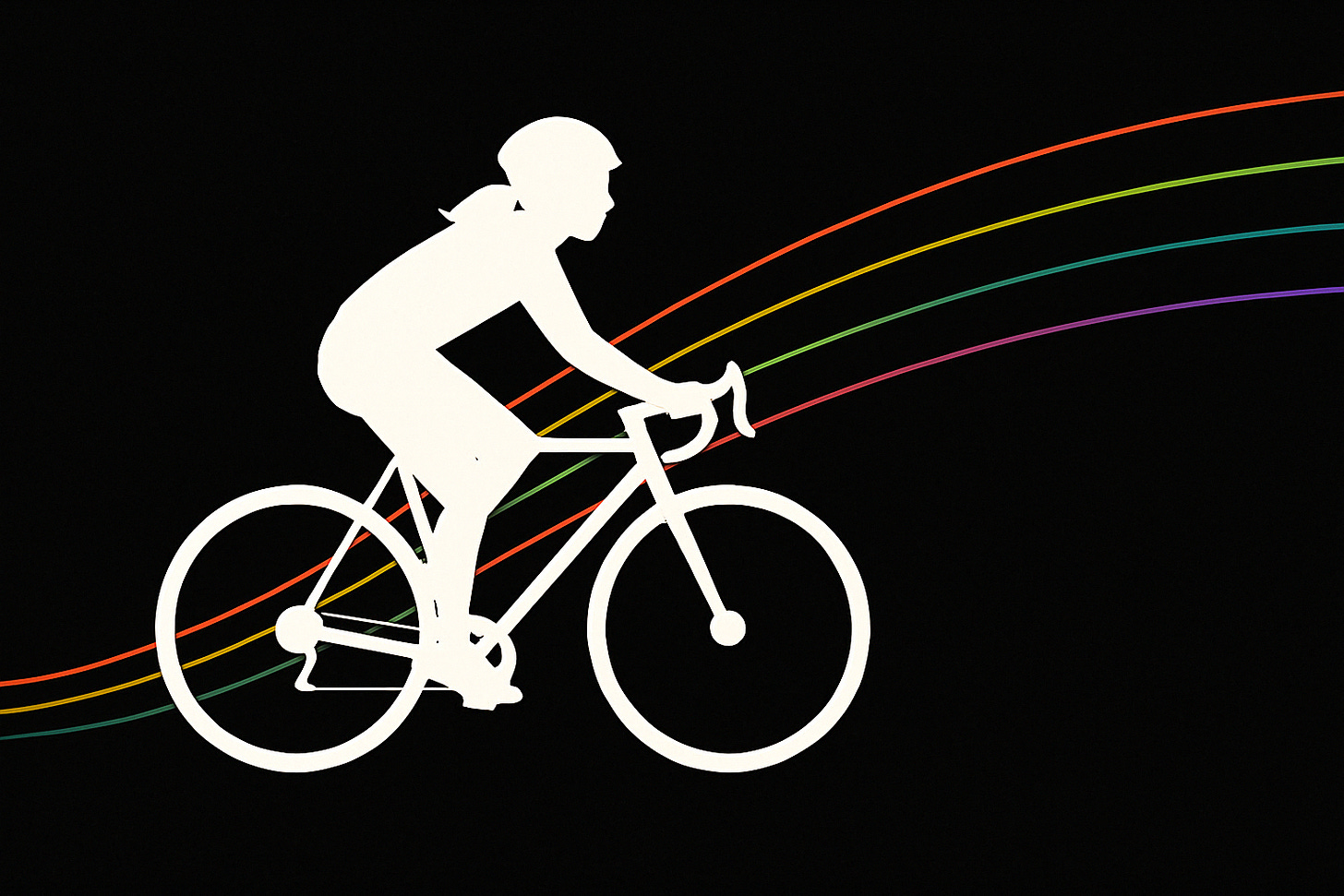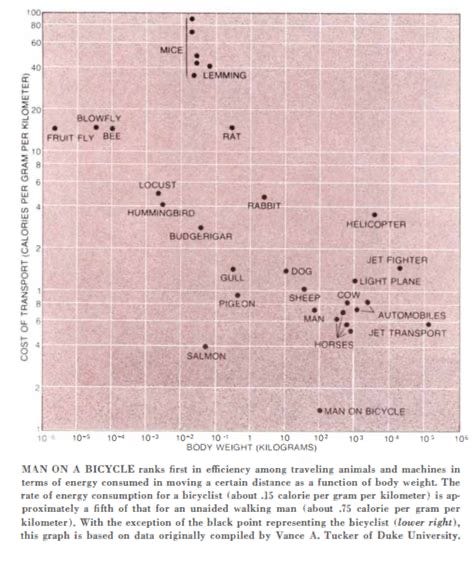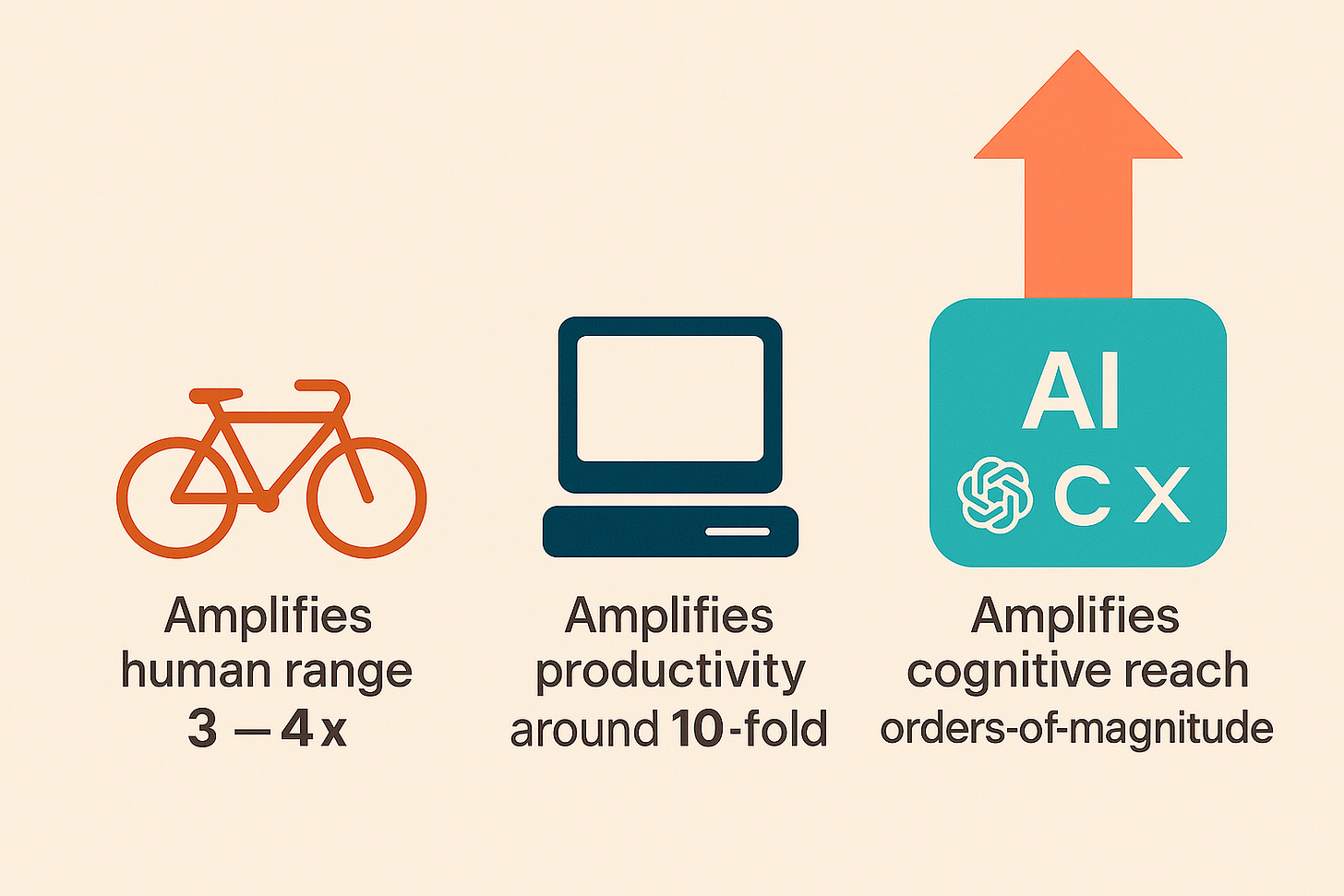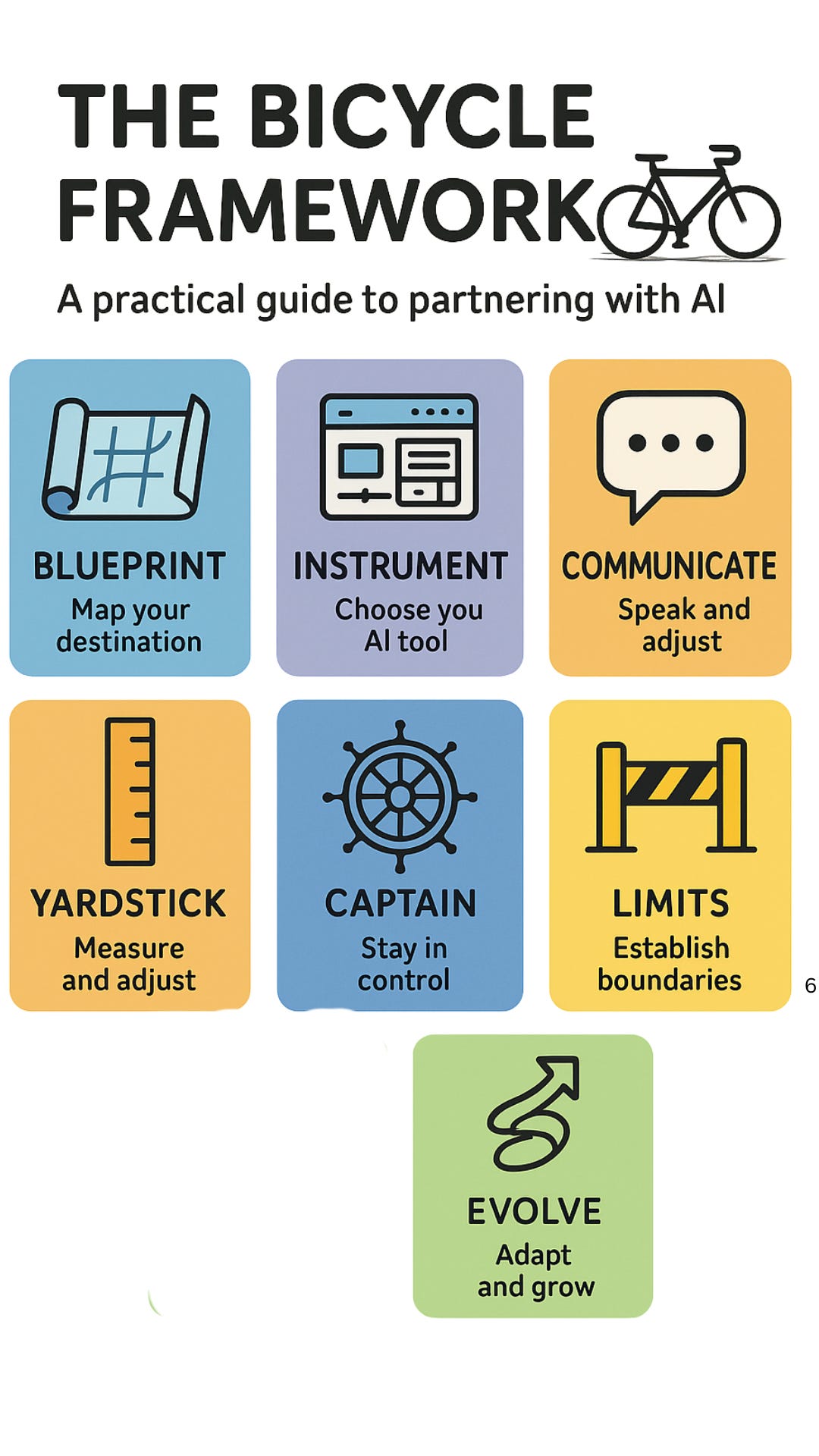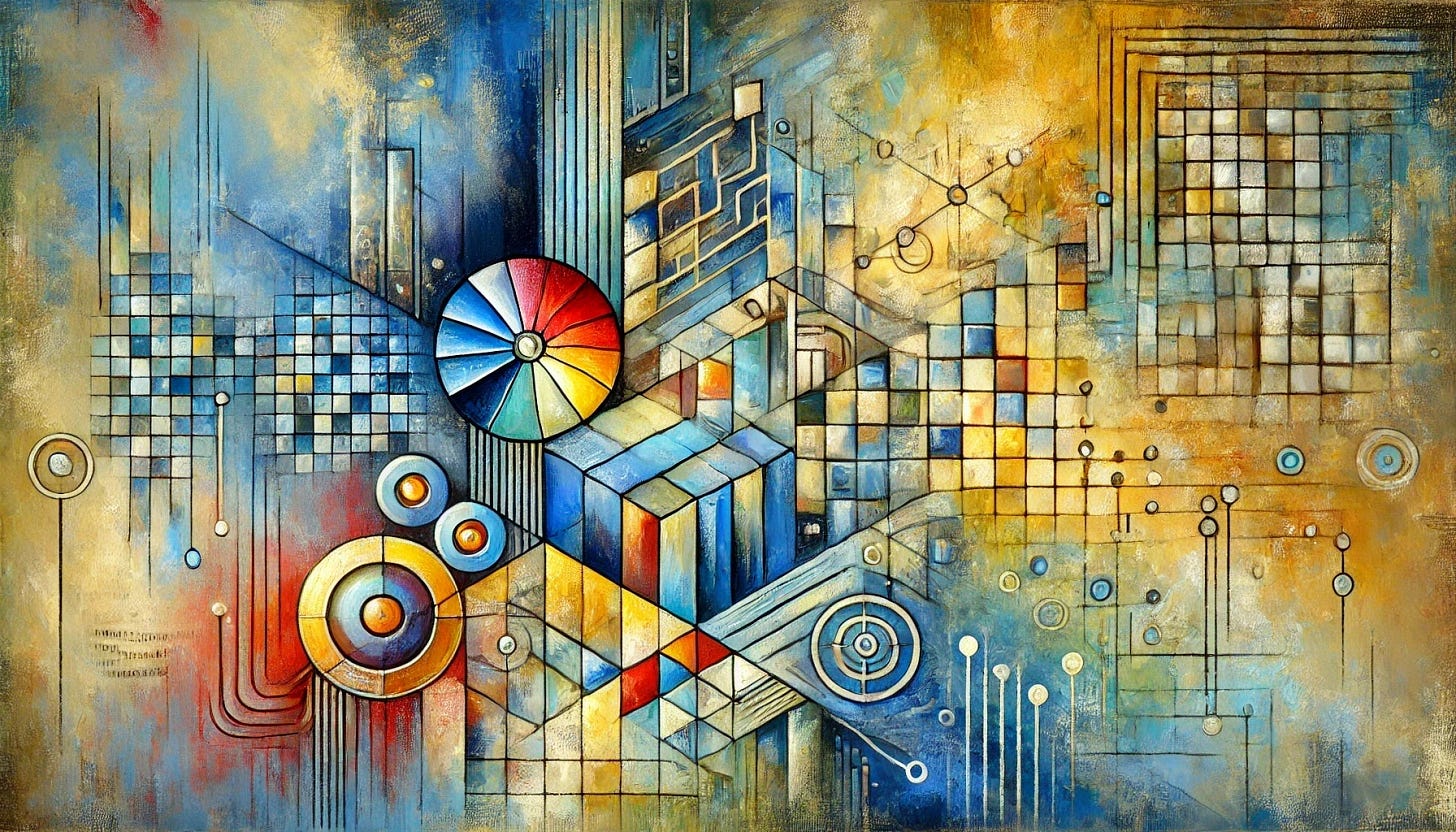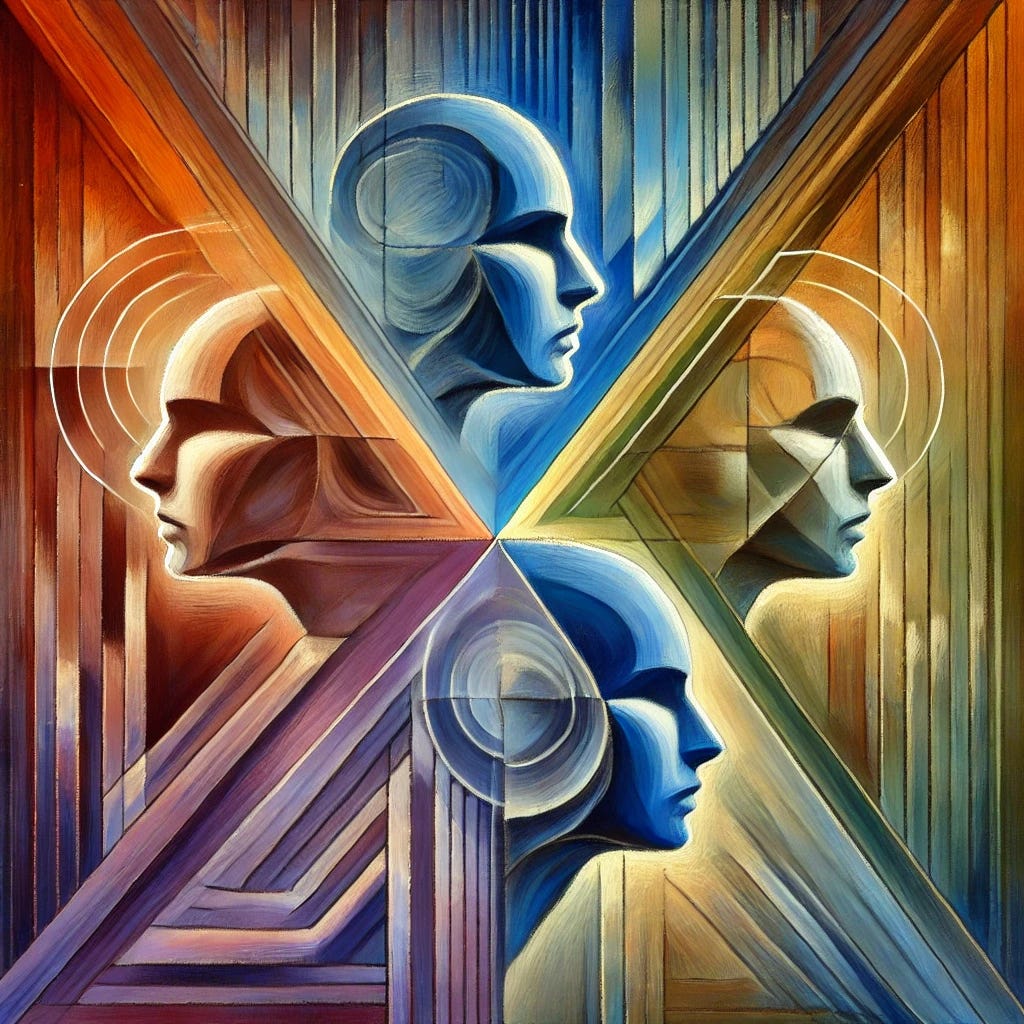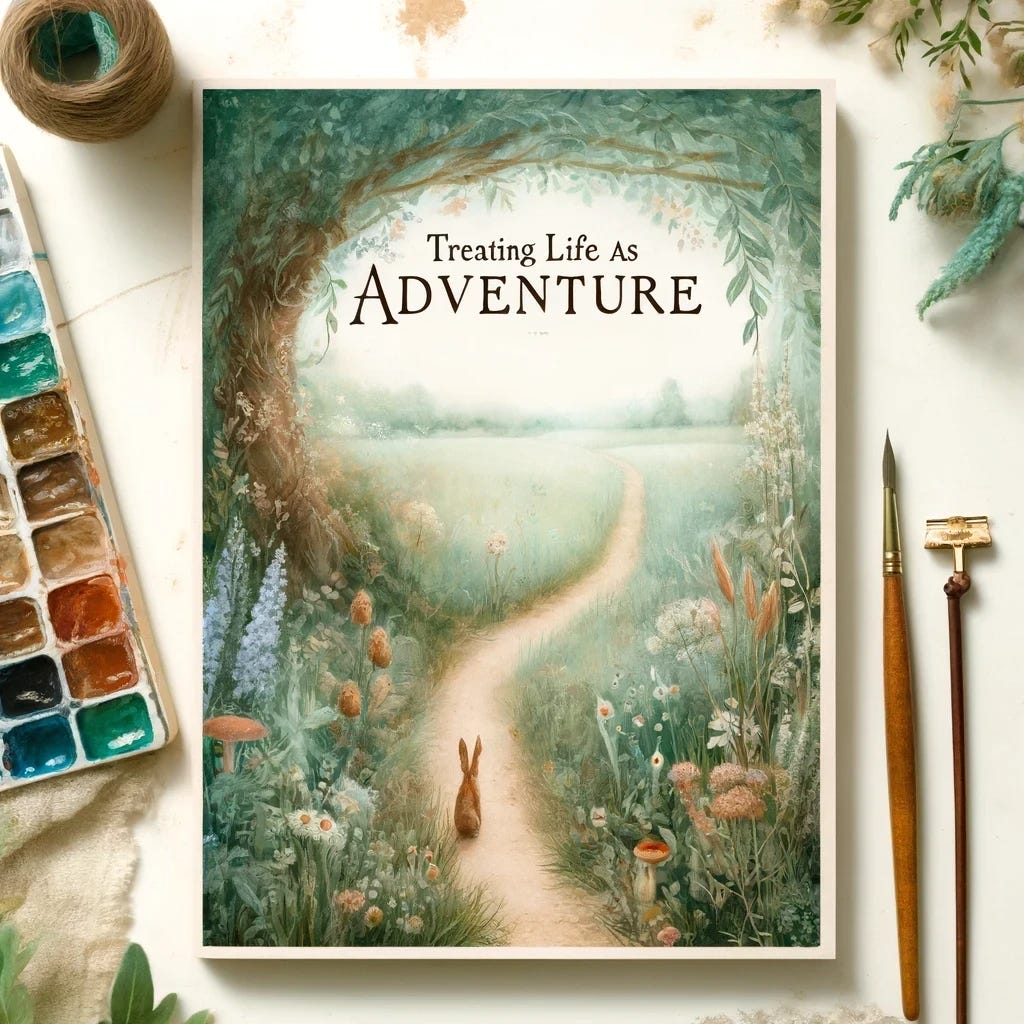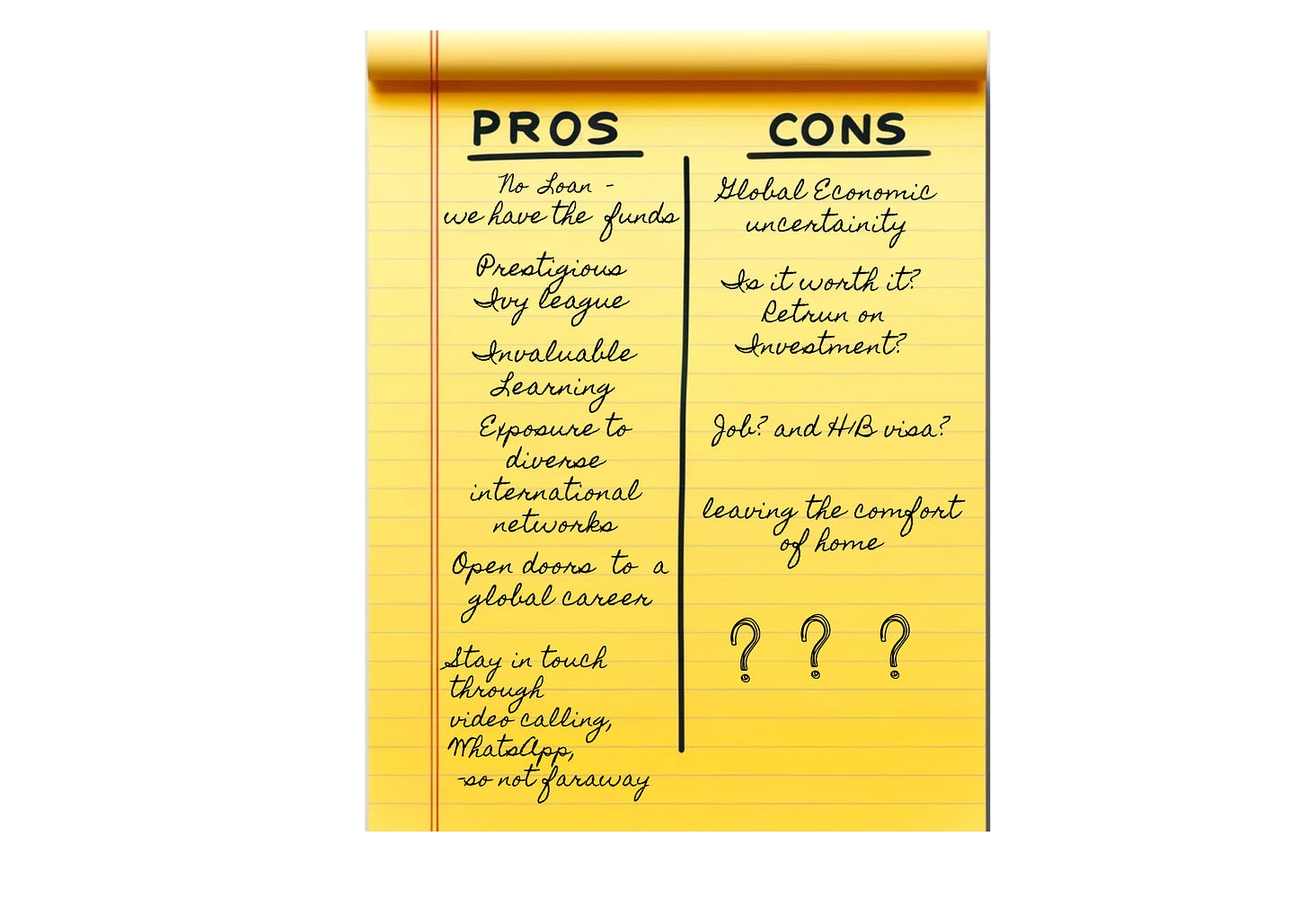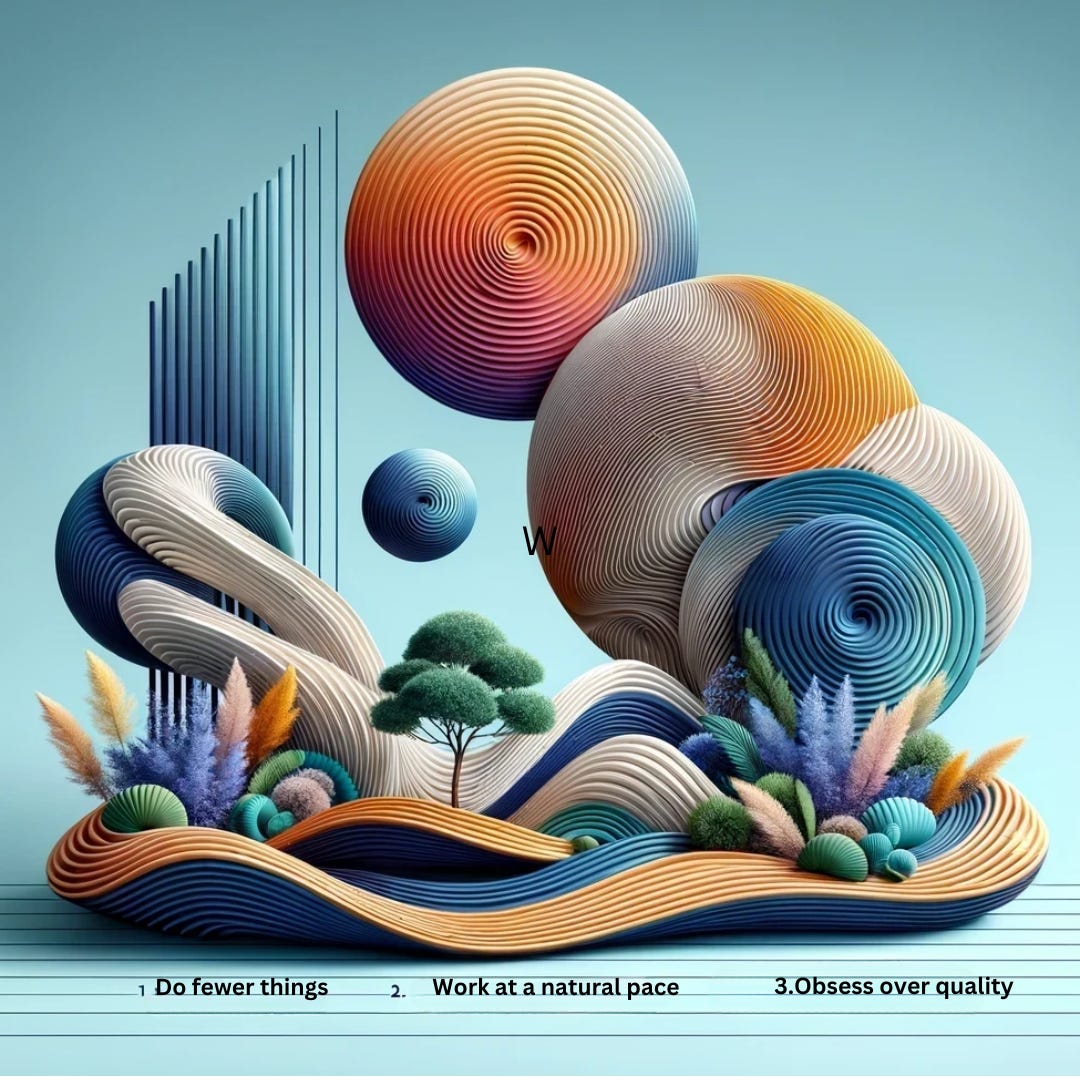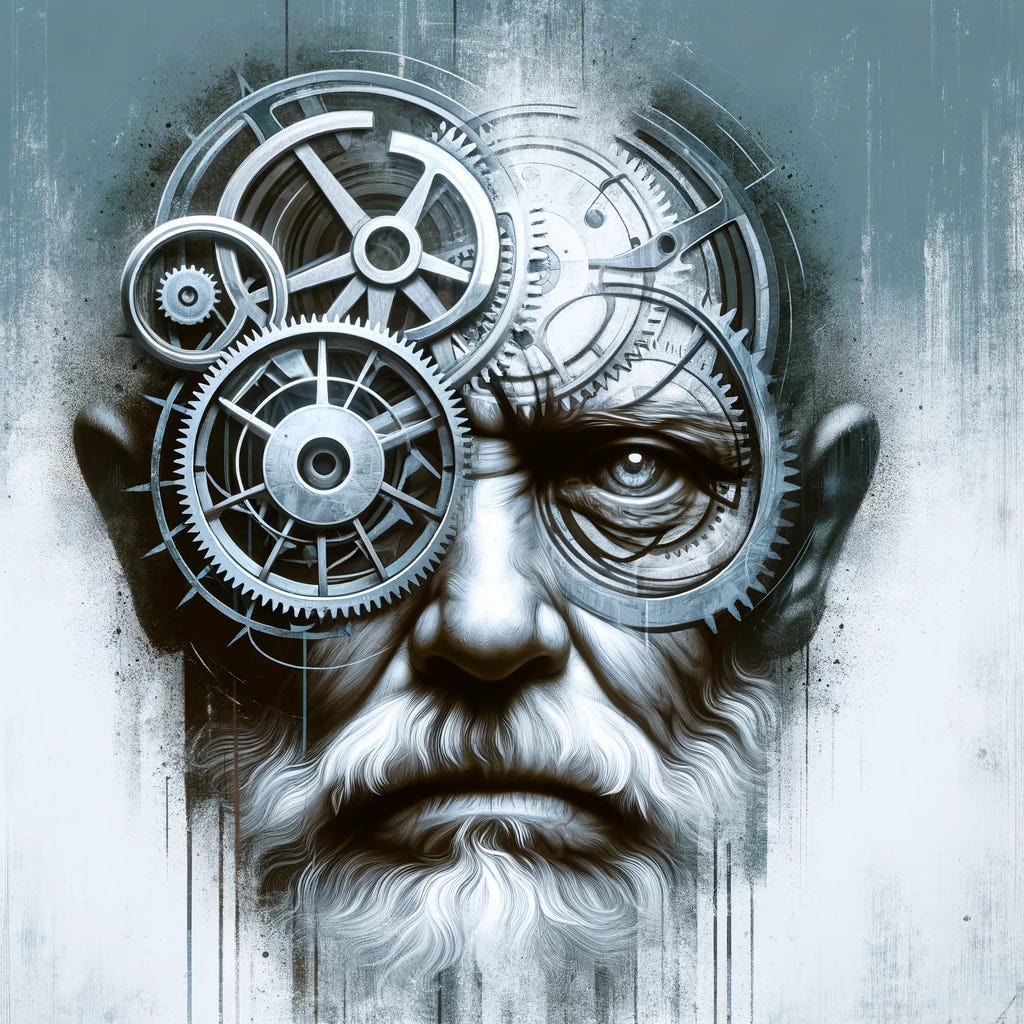“AI will not replace us; it will amplify us.” — Pedro Domingos,
In the March 1973 Scientific American article “Bicycle Technology,” S. S. Wilson plotted the cost of transport (calories / gram / km) against body weight for animals and machines, demonstrating how a person on a bicycle travels more efficiently than any other creature or machine when measured pound for pound.
About seventeen years later, Steve Jobs built on this insight during a Library of Congress interview in 1990. He said,
“I think one of the things that really separates us from the high primates is that we’re tool builders. I read a study that measured the efficiency of locomotion for various species on the planet. The condor used the least energy to move a kilometre. And, humans came in with a rather unimpressive showing, about a third of the way down the list. It was not too proud a showing for the crown of creation. So, that didn’t look so good. But, then, somebody at Scientific American had the insight to test the efficiency of locomotion for a man on a bicycle. And, a man on a bicycle, a human on a bicycle, blew the condor away, completely off the top of the charts.
And that’s what a computer is to me. What a computer is to me is it's the most remarkable tool that we’ve ever come up with, and it’s the equivalent of a bicycle for our minds.”
In today’s age of intelligence, Job’s metaphor is even more relevant.
Now AI amplifies our cognitive reach – our ability to find patterns, generate language, understand complex systems, and solve intricate problems – by orders of magnitude beyond what was previously possible.
AI, like most transformative technologies, grows gradually, then arrives suddenly.
Experimenting with Co-Intelligence
Till a year ago, I viewed the developments in AI with detached interest, but that changed after I read Co-Intelligence. In his brilliant book, Ethan shared four rules to engage with AI and the first rule, ‘Always invite AI to the table,’ changed my attitude to using AI. I began reading and writing with AI, even taking it along on walks to discuss ethical dilemmas or challenging ideas on my iPhone. It felt like reliving my childhood moments. – that exhilarating sensation when the wobbly uncertainty of the bicycle suddenly transforms into smooth forward motion.
The results are tangible. Within a month, the time I spent preparing for coaching sessions had decreased by half. More importantly, the quality and productivity increased. I summarise the key insights immediately from the transcript and share the action plans with my coachee.
I could easily evaluate the quality of each call against defined coaching competencies to identify areas where I was not giving my best and how I was performing in each marker as my calls progressed. I found, for example, that I had to be more comfortable with silence, giving the coachee space to think through the question I had asked.
Do I contradict myself?
Very well, then I contradict myself,
(I am large, I contain multitudes.)-
Walt Whitman, Song of Myself

I wanted to know if I could create a framework, based on my experiments, that would allow anyone to start partnering with AI without getting lost in all the details and develop their intuitive understanding about AI.
The BICYCLE framework offers exactly that – a practical methodology for partnering with AI across any profession. Imagine you are Dr.Watson, and in a role reversal, Sherlock Holmes assists you. While this is a partnership where you are in control, steering the course, Sherlock is a brilliant and extraordinarily useful character and can play a multitude of roles to help you solve the challenges in your life.
The framework has seven ’gears’ that you can use highlighting key aspects of effective collaboration with AI.
Artificial intelligence is not a substitute for human intelligence; it is a tool to amplify human creativity and ingenuity. Fei Fei Lee
B - Blueprint (Map your destination)
Just as you know where you're headed on a bike, you should set clear goals when using AI. Ask yourself what question you want to answer or what problem you need to solve. A clear direction keeps your work with AI focused and aligned with your needs.
I - Instrument (Choose your AI tool)
Just as you choose different bikes for various terrains—like using a road bike for smooth paths and a mountain bike for rough trails—you should select the right AI tool for your specific tasks. Each AI has its own personality, quirks, and capabilities. I use Claude as my writing partner, ChatGPT o3 as a sounding board for reasoning and analysis, and Grok for direct feedback.
C - Communicate (Speak effectively to AI)
Clear communication is essential for effective use. This involves making prompts that provide the right balance of context and instruction for the journey ahead.
Y - Yardstick (Measure and adjust outputs)
An experienced cyclist adjusts her efforts based on changing conditions. Similarly, working with AI requires continual improvement of its responses over time. First, closely examine the initial output. Then, pose follow-up questions to gather more details or seek clarification. You can also adjust settings, such as creativity or specificity, to achieve the desired results.
C - Captain (Stay in control of the process)
When riding a bicycle, you keep your hands on the handlebars; likewise, with AI, you maintain control through your expertise and judgment. Evaluate the AI's suggestions in light of your professional expertise. Identify what is useful, what requires improvement, and what should be completely disregarded. Always remember that you are the domain expert guiding the process.
L - Limits (Establish boundaries)
AI comes with inherent risks, making it crucial to understand its boundaries. Just as you use brakes when going down a steep hill, it’s important to recognise the limits and potential dangers of AI. To stay safe, follow these steps: be vigilant about biases, protect sensitive information, verify your sources, and understand where AI's capabilities end.
E - Evolve (Adapt and grow your skills)
The rapid evolution of AI means you must also adapt to keep up. Just as becoming a skilled cyclist requires regular practice and bike maintenance, mastering AI demands continuous learning and improvement. Experiment with new tools and techniques, enhance your prompting skills, develop efficient workflows, and stay informed about the latest advancements in the field.
Bicycling to become a Better Coach
This approach has transformed my executive coaching practice for the better. As coaches, we listen deeply, analyze information, ask good questions, and help people grow. AI enhances these skills by allowing me to research industry trends and changes more quickly. It aids my learning by synthesising information across seemingly unrelated areas. Additionally, it helps me identify potential biases or blind spots in my thinking by rigorously evaluating my coaching performance against established International Coach Federation competencies- the gold standard for coaches.
AI facilitates the creation of resources, like exercises and client surveys. Finally, it serves as a valuable partner as I prepare for difficult conversations. Through this partnership, I can cover more intellectual ground and develop deeper insights, ultimately becoming a more effective coach.
When clients see the results, they become curious about developing their own AI partnerships
Some people worry that artificial intelligence will make us feel inferior, but then, anybody in his right mind should have an inferiority complex every time he looks at a flower. Alan Kay
Amplify who you are
You might be on the sidelines, like I was, hesitating to begin working with AI. Your concerns are valid, but they shouldn't stop you from improving your skills. I worry that relying too much on AI could increase my dependence on it to a point that it would hold me back. To avoid this, I ensure that I do not use it in a way that weakens my abilities. Ironically, working with AI helps me better understand my skills, which I make sure to hone and protect.
I encourage you not to dabble but to make a serious commitment, use the paid version of any AI you have in mind. Consider starting with a small task where AI can assist you this week. Begin with something straightforward and utilize the BICYCLE framework to evaluate what works and what doesn’t. Reflect on your experience, and as you build confidence, gradually tackle more complex tasks.
Working with AI is like learning to ride a bicycle. It takes practice and persistence. You may make mistakes or face challenges. However, the benefits of partnering with AI—the ability to think more broadly, solve problems better, and create more easily—make it worth the effort.

